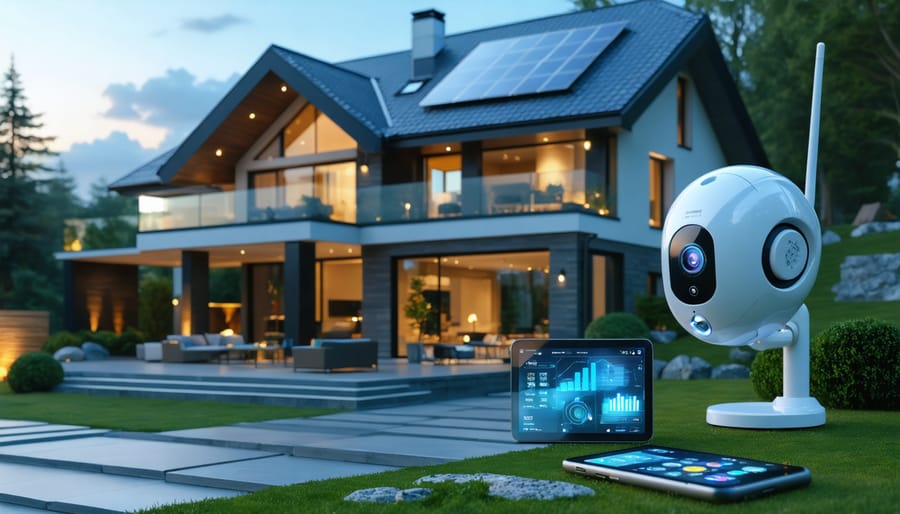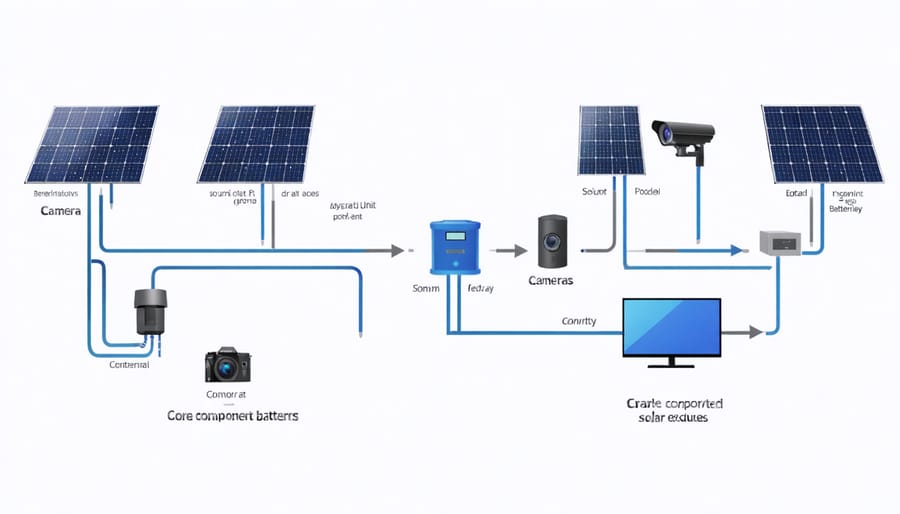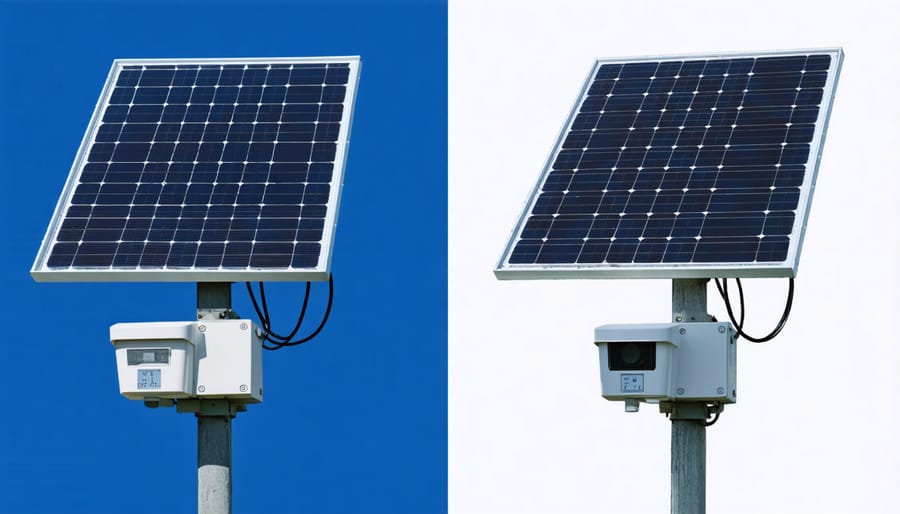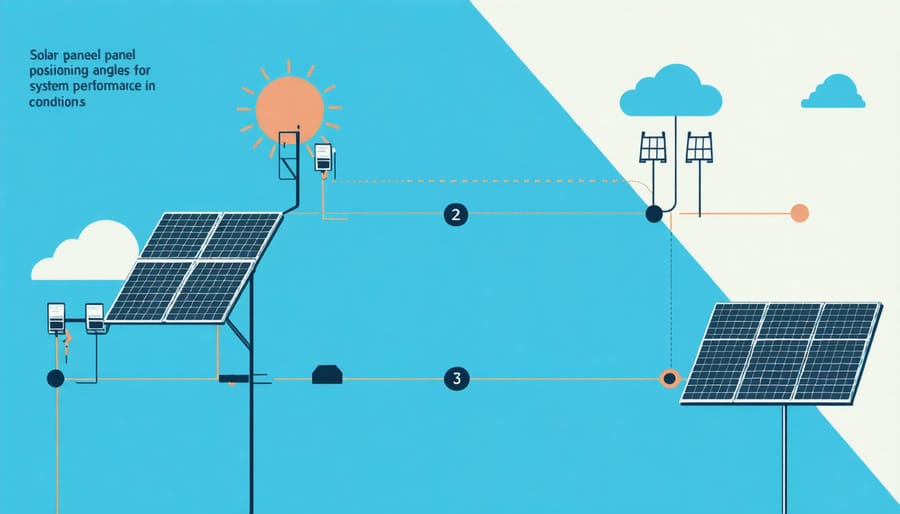Solar-Powered Security: Keep Your Home Safe Without Grid Dependency

In an era where sustainable living meets cutting-edge technology, solar-powered houses represent the pinnacle of modern residential innovation. These self-sufficient homes harness the sun’s boundless energy, transforming everyday living spaces into sophisticated power-generating systems that dramatically reduce both environmental impact and energy costs. By integrating advanced photovoltaic panels with smart home technology, today’s solar-powered houses offer European homeowners an unprecedented level of energy independence while maintaining optimal comfort and functionality.
Beyond mere energy production, these sustainable dwellings showcase how thoughtful architectural design and renewable technology can work in perfect harmony. With the European Union’s ambitious climate goals driving renewable energy adoption, solar-powered houses have evolved from experimental concepts to practical, future-proof investments. Modern systems can now generate surplus power for energy storage or grid feed-in, creating homes that not only consume zero net energy but actually contribute to a more sustainable energy network.
How Solar-Powered Security Systems Work
Core Components
A solar-powered house relies on three fundamental components working in perfect harmony. At its heart are high-efficiency photovoltaic panels, typically installed on the roof or in the garden area, which convert sunlight into electricity. Modern European solar panels achieve conversion rates of up to 23%, ensuring optimal energy generation even in variable weather conditions.
The second crucial element involves advanced solar power storage solutions, primarily lithium-ion batteries, which store excess energy for use during nighttime or cloudy periods. These storage systems have evolved significantly, now offering improved capacity and longer lifespans, typically lasting 10-15 years with proper maintenance.
The third component encompasses smart security devices integrated with the solar system. This includes energy-efficient LED security lighting, solar-powered CCTV cameras, and automated monitoring systems. These devices are designed to operate continuously while consuming minimal power, ensuring your home remains secure without compromising energy efficiency. Modern systems also feature remote monitoring capabilities, allowing homeowners to track both energy consumption and security status through smartphone applications.

Integration and Installation
The integration of a solar power system into your home requires careful planning and professional expertise. The process typically begins with a detailed site assessment, where certified installers evaluate your roof’s orientation, angle, and structural integrity. They’ll also assess your home’s electrical infrastructure to ensure compatibility with solar components.
Installation usually takes between 2-5 days, depending on system size and complexity. The process involves mounting solar panels on your roof using specialized racking systems, installing the inverter (typically in your garage or utility room), and connecting the system to your home’s electrical panel. A bi-directional meter is also installed to monitor both energy consumption and production.
Modern solar-powered houses feature smart integration capabilities, allowing you to monitor system performance through mobile apps or web interfaces. These platforms provide real-time data on energy production, consumption patterns, and potential savings. For enhanced functionality, the system can be connected to home automation systems, enabling intelligent energy management and optimal power distribution throughout your property.
It’s essential to work with certified installers who understand local regulations and can ensure compliance with European energy standards while maximizing system efficiency.
Key Benefits of Solar Security Systems
Energy Independence and Reliability
A solar-powered house offers unparalleled energy independence, enabling homeowners to generate their own clean electricity and reduce reliance on the traditional power grid. By harnessing solar energy, these homes can operate autonomously, particularly during daylight hours, ensuring a consistent power supply even during network outages or grid instability.
Modern solar installations typically include advanced battery storage systems, allowing excess energy generated during sunny periods to be stored for use during nights or cloudy days. This storage capability transforms solar homes into reliable power stations, capable of maintaining essential operations during extreme weather events or grid failures.
The integration of smart energy management systems further enhances reliability by optimising power consumption and distribution throughout the house. These systems automatically prioritise critical loads during limited power situations and can seamlessly switch between solar, battery, and grid power as needed.
For European homeowners, energy independence brings significant financial benefits through reduced utility bills and protection against rising energy costs. Many countries offer feed-in tariffs or net metering programmes, allowing surplus power to be sold back to the grid, creating an additional revenue stream.
Most importantly, solar-powered houses provide peace of mind through energy security. Whether facing regional power disruptions or seeking to reduce dependency on external energy sources, these systems ensure continuous power supply for essential home functions, from heating and cooling to security systems and home offices.

Cost Savings and Environmental Impact
Investing in a solar-powered house delivers substantial long-term solar cost benefits, with most homeowners experiencing a return on investment within 6-8 years. The average European household can reduce their annual energy bills by 50-70%, resulting in savings of €1,000-1,500 per year, depending on location and system size.
Beyond financial advantages, solar-powered homes significantly reduce their carbon footprint. A typical 4kW residential solar system prevents approximately 3.5 tonnes of CO2 emissions annually – equivalent to planting 150 trees. This contribution to environmental preservation aligns with EU climate goals and supports the transition towards sustainable living.
The environmental impact extends beyond emissions reduction. Solar installations reduce dependency on fossil fuels, minimize water consumption associated with traditional power generation, and contribute to improved air quality. Modern solar systems are also increasingly recyclable, with up to 95% of components recoverable at end-of-life, supporting circular economy principles.
Furthermore, solar-powered homes often benefit from increased property values, with studies showing a 4-6% premium over conventional properties. Combined with various European incentives and feed-in tariffs, the overall financial and environmental advantages make solar power an increasingly attractive investment for homeowners committed to sustainable living.
Choosing the Right System
System Sizing and Requirements
Determining the right system size for your solar-powered house begins with a thorough assessment of your energy consumption patterns. Start by reviewing your annual electricity bills to establish your average daily usage in kilowatt-hours (kWh). This baseline helps calculate the number of solar panels needed to maximize solar energy potential for your property.
Key factors influencing system sizing include available roof space, roof orientation, local climate conditions, and shading patterns. A typical European household requires between 3-6 kW of solar capacity, translating to 12-24 panels, depending on efficiency ratings and regional solar irradiance levels.
Essential components include:
– Solar panels (monocrystalline or polycrystalline)
– Inverter (string or microinverters)
– Battery storage system (recommended for optimal self-consumption)
– Mounting equipment
– Smart monitoring system
Professional installers will conduct a detailed site survey to determine precise requirements and recommend appropriate component specifications. They’ll consider factors like grid connection requirements, local building regulations, and future expansion possibilities to ensure your system delivers optimal performance and return on investment.
Climate Considerations
Local climate conditions play a crucial role in determining the efficiency and performance of a solar-powered house. In Europe, solar exposure varies significantly across regions, from the Mediterranean’s abundant sunshine to the Nordic countries’ seasonal variations. Understanding your location’s specific weather patterns and solar irradiance levels is essential for optimising system design and energy generation potential.
Most European regions receive between 1,000 and 2,000 hours of sunshine annually, with southern regions typically enjoying more solar exposure. However, modern solar technology performs effectively even in areas with less direct sunlight, thanks to advanced photovoltaic panels that can harness diffused light on cloudy days.
Seasonal variations affect solar power generation throughout the year. While summer months provide peak production periods, winter months see reduced output due to shorter days and increased cloud cover. This natural cycle influences system sizing decisions, with many homeowners opting for slightly larger installations to maintain adequate power generation during lower-yield periods.
Local factors such as rainfall, snow, and temperature fluctuations also impact system performance and maintenance requirements. Professional installers account for these variables when designing system specifications, ensuring optimal placement and selecting appropriate equipment for specific climate conditions.

Maintenance and Optimization
Regular maintenance and optimization are crucial for maximising the performance of your solar-powered house system. Start with quarterly visual inspections of solar panels to check for dust, debris, or damage. In European climates, autumn leaf fall and spring pollen can significantly impact panel efficiency, making seasonal cleaning essential.
Monitor your system’s performance through its integrated monitoring software, paying attention to daily and monthly energy production patterns. Unexpected drops in output might indicate issues requiring professional attention. For optimal efficiency, ensure panels maintain their ideal tilt angle, typically between 30-45 degrees in most European locations.
Battery systems require annual professional checks to verify proper function and connection integrity. Replace batteries according to manufacturer recommendations, usually every 8-10 years, to maintain reliable energy storage capacity.
Inverter maintenance is equally important; these devices typically need replacement every 10-15 years. Keep the area around your inverter well-ventilated and free from dust to prevent overheating.
Consider scheduling professional maintenance visits during spring to prepare for peak summer production. Many European installers offer comprehensive maintenance packages that include system optimization, performance analysis, and necessary upgrades.
To maximize system longevity, maintain proper documentation of all maintenance activities and system modifications. This record-keeping proves invaluable for warranty claims and future system upgrades, ensuring your solar investment continues delivering optimal returns for decades.
Solar-powered houses represent a pivotal shift towards sustainable living in Europe’s residential landscape. As energy costs continue to rise and environmental awareness grows, these innovative homes offer a practical solution for homeowners seeking both economic and ecological benefits. The integration of solar technology with modern home design has proven that sustainable living doesn’t require compromise on comfort or functionality.
Looking ahead, the future of solar-powered houses appears increasingly promising. Technological advancements in solar panel efficiency, energy storage solutions, and smart home integration are making these systems more accessible and effective. With supportive EU policies and growing investment in renewable energy infrastructure, solar-powered homes are set to become the new standard in European residential construction. This transition not only benefits individual homeowners through reduced energy costs but also contributes significantly to Europe’s broader climate goals and energy independence objectives.
Leave a Reply